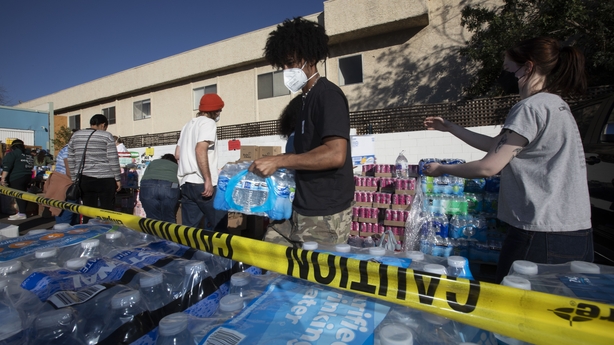A week ago, tens of thousands of Los Angeles County residents fled their homes, many with just the clothes on their backs and the few precious possessions they could hastily grab on their way out the door.
Many watched in horrified disbelief as the TV pictures showed hurricane-force winds intensifying the deadly blaze, overwhelming fire crews and reducing entire neighbourhoods to dust.
Last Tuesday night, Rhona Cleary from Sligo, looked out her kitchen window in the suburb of Altadena, Los Angeles.
"I could see the fire from my kitchen window and thought: oh my goodness! - I knew this was kind of serious," she said.
However, Ms Cleary and her husband Kieran's house was located near the outer edge of the neighbourhood.
There was a chance it would be far enough away from the fire to survive.
"When we were packing the car, Kieran said to me - will we put in the memory box?" she said.
The memory box contained some favourite school projects that their children had done over the years.
"I said no," she said, adding "silly me".
Rhona and Kieran’s house burnt to the ground.
Reflecting on her feelings a week on, "it feels like losing a close family member," she said.
City of Angels
They call Los Angeles 'the City of Angels’, this week it felt like a city of lost souls.
"I went from working hard, reaching goals, to not knowing what the future is," said Mark, from Hollywood, who evacuated to a temporary shelter run by the American Red Cross.
"The folks that I was working for also lost everything," he said, adding he didn’t know how he was going to earn an income now.
"I’m hitting a sponge golf ball against this wall of this recreation centre" he explained, "just to try and focus and get frustrations out".
Read more:
Los Angeles firefighters hold the line despite extreme conditions
Watch: LA 'not out of danger' as locals question readiness
In every neighbourhood RTÉ News visited, a quiet grief hung in the air.
In a bookshop in the chic suburb of Santa Monica, a woman was buying a paperback book to replace one her husband had lost when their house burnt down.
"His was a hardback, but I think this will be fine," she told the shop keeper.
"I’m sorry," the shopkeeper said.
"I’m just so sorry".
Evacuation orders stay in place
At a checkpoint on Sunset Boulevard on the way into the Pacific Palisades, one of the worst-affected neighbourhoods, National Guard officers were turning people away.
The fire zone remained under a mandatory evacuation order.
Lines of cars formed as residents waited for hours for a chance to go back to where their house once stood, to see if anything could be salvaged.
In an effort to stop looters and minimise the risk from unsafe structures, officials said that the only way in was under police escort or by showing press credentials, which were closely scrutinised.
They had seen people pretending to be from the media, one officer explained.

"We’ve also seen people dressed up as first responders," he said, before waving me and camera operator Ben Bishop through, apparently satisfied we were who we said we were.
Near the top of the hill, sits Palisades Village, an upmarket outdoor shopping mall with boutiques, cafés and an independent cinema behind bright white facades.
For acres on either side, the Palisades Fire left a scene of near-total destruction.
But "the village" survived intact.
The billionaire owner of the development and former mayoral candidate Nick Caruso hired teams of private firefighters equipped with mobile tanks of water to protect the buildings.
It raised questions about the resourcing and preparedness of the city and state firefighters.
Questions for the authorities
Local authorities were criticised after fire hydrants in the same area ran dry, as fire crews battled the blazes last week.
"We pushed the system to the extreme," Janisse Quinones, the chief executive of the Los Angeles Department of Water and Power, told a news conference last week.
"Four times the normal demand was seen for 15 hours straight, which lowered our water pressure," she added.
Governor of California Gavin Newsom announced an investigation into the matter on Friday, possibly the first of several enquiries into the events of last week.
The first response was additionally hampered by hurricane-force Santa Ana winds, which grounded the helicopters and aircraft used to drop water and flame retardant from the sky.
Once embers are propelled by wind over a wide area, Captain John Clingingsmith Jr, a spokesperson with Cal Fire told RTÉ News, fires become very difficult to contain.

"People need to remember that fire can walk, run, jump and fly," he said, "and a lot of that is with the winds and the embers".
"So that's what we are really working hard the last couple of days to try and get around this fire to reduce the risk of those embers being flown," he said.
A long road ahead
As the smoke began to clear across Los Angeles in the past few days, air quality improved, and the dust began to settle, quite literally.
A fine layer of soot could be seen on outdoor furniture, even in areas some distance from the fire zones.
Pavements and hedgerows were also grey with ash.
There has been an outpouring of community support for the tens of thousands of people displaced by the fires.
Donation centres popped up all over the city. Restaurants and cafés gave out free food and drinks.
However, there were plenty of people ready to take advantage of the situation too.
A surge in demand for rental accommodation saw prices skyrocket, in a city that already has some of the most expensive in America. City officials warned that "price-gouging" was illegal.
Rhona and Kieran Cleary are planning to rebuild their house in Altadena because it is a community they love.
"But we’ve a long road ahead," Ms Cleary said.







